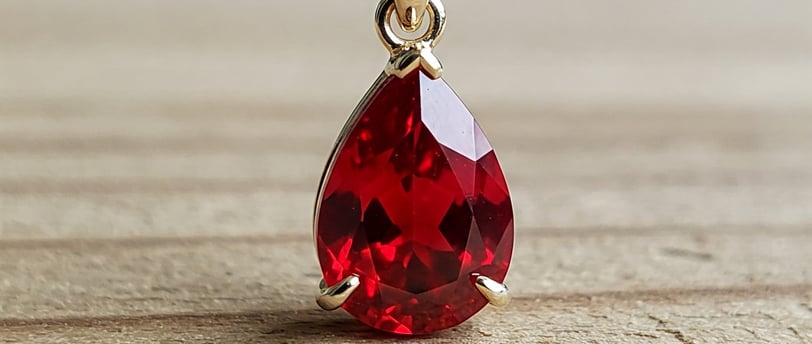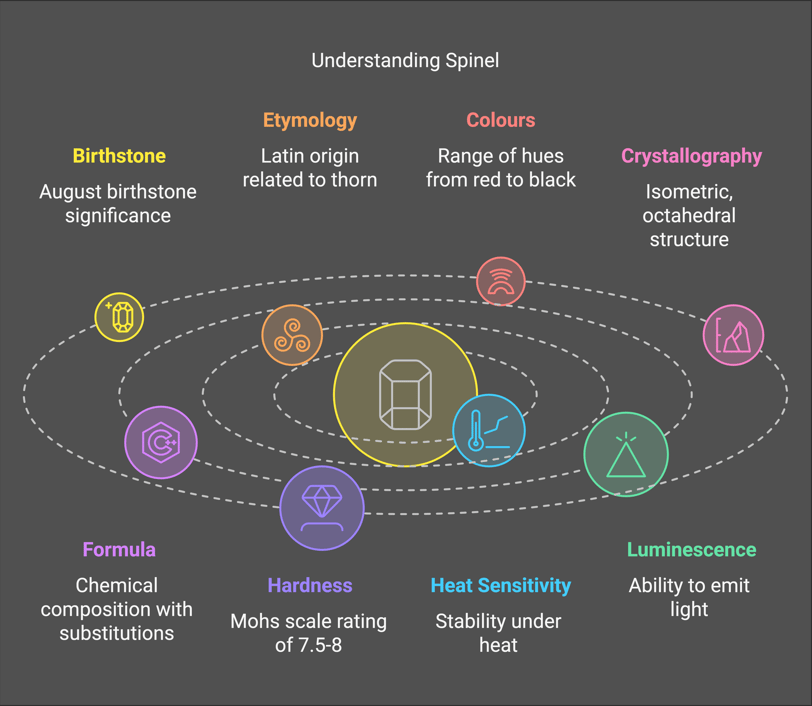Spinel
Spinel: The Gemstone Imposter No More - Discover the fascinating history and vibrant colours of spinel, a gemstone finally stepping into the spotlight after centuries of mistaken identity.
1/30/20254 min read


History
Spinel has a long and fascinating history, often playing the role of the great imposter. For centuries, many fine red spinels were mistaken for rubies. In fact, some of the most famous "rubies" in history, including the Black Prince’s Ruby and the Timur Ruby, both part of the British Crown Jewels, are actually spinels. It was not until 1783 that mineralogist Jean Baptiste Louis Rome de Lisle identified spinel as a distinct mineral from ruby. This differentiation marked the birth of the science of gemology. Despite its unique identity, spinel has often been discussed in terms of how well it simulates rubies or sapphires. The historical association with rubies has led to some spinels being mislabeled as "ruby spinels" or "spinel rubies," which is misleading. The term “balas rubies,” historically used for spinels, should only be used when discussing gemstone history.
Mineral Origins
The gemstone known as spinel is part of a group of related minerals called the spinel subgroup, all of which are isometric aluminum oxides with magnesium, iron, zinc, and other trace elements. The spinel species itself is the only member of this subgroup commonly used in jewellery. Spinel is typically found in metamorphic rocks and their weathering products, particularly in contact deposits like marbles and limestones. Most spinels are recovered from alluvial or placer deposits, where they have been smoothed by stream action. The majority of gem-quality spinels are mined in Myanmar and Sri Lanka, with lesser amounts coming from Tanzania and Tajikistan. Spinel also occurs in many other countries including the United States, Afghanistan, and Vietnam.
The 4 C’s
The value of a spinel is determined by several quality factors:
Colour
Spinel occurs in a wide range of colours, from deep, rich shades to very light pastels. The most valued colours are vivid reds and cobalt blues, reminiscent of rubies and sapphires. Other highly desirable colours include vibrant hot pinks and vivid oranges. Red spinel, particularly pure red to slightly purplish-red hues with a medium to medium-dark tone, is the most sought after. Cobalt-blue spinels are also highly valued for their rich colour. Pink spinels, especially neon pinks from Tanzania and "Jedi" spinels from Myanmar, are also highly desirable. Less valuable colours include mauve-pink and light grayish purple. The colour’s saturation or “spectral purity” significantly impacts the price. Spinels with a medium tone and strong saturation command the highest prices.
Clarity
Spinel is classified as a Type II gemstone, meaning that it typically contains inclusions. The fewer inclusions there are, the higher the value. Eye-clean spinels, meaning those without visible inclusions, are highly prized, but small inclusions may not significantly affect the value of a top-colour stone. Some inclusions can be beautiful, reflecting the gem’s octahedral crystal growth and sometimes resembling human fingerprints. Inclusions can be used to distinguish natural from synthetic spinels.
Carat
The price per carat increases significantly at one carat. Fine red spinels over three carats are very rare. The price per carat for pink and purple spinels jumps again at three carats, while for blue stones, the increase occurs at four carats and at five carats for orange stones. Historically, there have been spinels over 100 carats. Large, high-quality matched sets of spinel are extremely rare.
Cut
Spinels are cut in various shapes to showcase their brilliance. Popular shapes for transparent crystals include cushion cuts, emerald cuts, rounds, and ovals. Opaque spinels and star spinels are typically cut as cabochons. The cut of a spinel is crucial for its brilliance; a well-cut spinel should sparkle evenly, reflecting light across the entire gem. Due to the scarcity of spinel, fine-quality rough is often cut to non-standard sizes to save weight.
Be Aware Of
Enhancements
Natural spinels are typically unenhanced. However, some may receive heat treatment or fracture filling to improve clarity. Fracture filling treatments are not permanent. Diffusion treatments may also be used to create artificial body colours in spinels. It is important to get a lab report for any significant purchase to verify if a spinel is natural and untreated.
Simulants
Spinel’s desirable qualities have led to its use as a simulant for other gemstones, both in natural and synthetic forms. Synthetic spinels, in particular, can imitate other well-known and expensive gemstones. Assembled doublets and triplets with synthetic spinels can be used to imitate other gems like emeralds. Manufacturers can also create moonstone and lapis lazuli imitations from synthetic spinels.
Synthetics
Synthetic spinels have been produced since the 19th century, using methods like flame fusion, flux, and the Czochralski methods. These synthetic spinels are common in birthstone jewellery and class rings. Most colourless spinels in jewellery are likely synthetic. Synthetics can imitate other gems but can be distinguished by a gemologist via their absorption spectrum, inclusions and fluorescence.
Final Thoughts
Buying Tips
When buying spinel, it is essential to look at different colours side by side to understand the range of qualities. The cut is a very important factor, and the spinel should sparkle evenly across the entire gem. Seek a knowledgeable jeweller who understands the specific needs of spinel. For significant purchases, a report from a gemological lab can confirm the spinel is natural. Pay attention to the saturation of colour, as this greatly impacts the price.
Jewelry Care
Spinel is a durable gemstone, well-suited for any type of jewellery. It has excellent resistance to scratches and a high refractive index, which means well-cut and polished gems will have excellent brilliance regardless of colour. To clean spinel jewellery, use warm water with gentle dish detergent, scrubbing gently with a soft brush. Remove spinel jewellery before sleeping.


Gemius Stones
Expertise
© 2025. All rights reserved.
